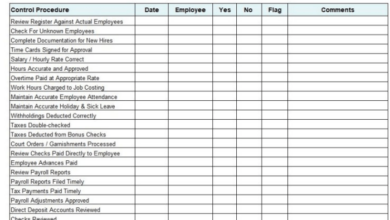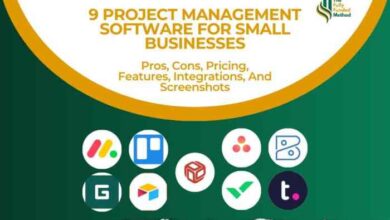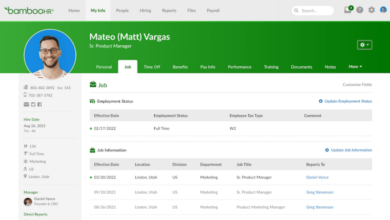
Best HR Software for Small Businesses: Streamline Your Operations
Best HR software for small businesses is no longer a luxury, it’s a necessity. In today’s competitive landscape, small businesses need every advantage they can get, and that includes efficient and effective HR management. The right HR software can automate tasks, streamline processes, and free up your time to focus on what matters most: growing your business.
This guide will explore the essential features of HR software, the benefits it offers, and the factors to consider when choosing the right solution for your small business. We’ll also provide a list of top HR software providers and tips for successful implementation.
By the end of this article, you’ll have a clear understanding of how HR software can help your small business thrive.
Understanding Small Business HR Needs
Small businesses are the backbone of many economies, contributing significantly to job creation and economic growth. However, they often face unique challenges when it comes to managing their human resources. Unlike larger organizations, small businesses may have limited resources, smaller teams, and less specialized HR expertise.
This can make it difficult to effectively manage tasks like recruitment, onboarding, payroll, performance management, and employee benefits.
Core HR Challenges Faced by Small Businesses
Small businesses often grapple with various HR challenges, making it essential for them to choose the right HR software to streamline their processes and improve efficiency.
- Limited Resources:Small businesses typically have limited budgets and staff, making it challenging to dedicate significant resources to HR tasks. This can lead to inefficiencies, delays, and potential compliance issues.
- Lack of HR Expertise:Many small business owners lack specialized HR knowledge, which can result in mistakes, inconsistencies, and legal complications.
- Time Constraints:Small business owners often wear many hats, leaving them with limited time to focus on HR-related matters. This can lead to neglecting important HR tasks and potentially impacting employee morale and productivity.
- Compliance Issues:Keeping up with constantly evolving employment laws and regulations can be a significant burden for small businesses. Non-compliance can lead to hefty fines and legal repercussions.
- Employee Engagement:Maintaining a positive and engaging work environment can be difficult for small businesses, especially when dealing with limited resources and communication challenges.
Features of Small Business HR Software
Small business HR software should be designed to address the specific needs and challenges of smaller organizations. It should be user-friendly, affordable, and offer a range of features to streamline HR processes.
- Simplified Onboarding:Onboarding new employees smoothly is crucial for small businesses. HR software should provide tools to automate onboarding processes, such as collecting employee information, assigning tasks, and providing access to relevant documents and resources.
- Automated Time and Attendance Tracking:Efficient time and attendance tracking is essential for payroll accuracy and productivity monitoring. HR software should offer features to track employee hours, manage leave requests, and generate reports for payroll purposes.
- Payroll Management:HR software should simplify payroll processing by integrating with payroll providers or offering built-in payroll features. This helps ensure accurate and timely payments, reducing administrative burdens.
- Performance Management:Performance management is essential for employee development and motivation. HR software should provide tools for setting goals, conducting performance reviews, and providing feedback to employees.
- Employee Communication:Effective communication is vital for building a positive work environment. HR software should offer features for internal communication, announcements, and employee surveys.
- Compliance Management:HR software should help small businesses stay compliant with labor laws and regulations. This may include features for managing employee records, tracking compliance deadlines, and providing access to relevant legal resources.
Comparison of HR Needs Between Small and Large Businesses
While both small and large businesses require HR functions, there are significant differences in their needs and priorities.
| Feature | Small Businesses | Large Businesses |
|---|---|---|
| HR Staff | Often have limited or no dedicated HR staff. | Typically have dedicated HR departments with specialized roles and expertise. |
| Budget | Limited budgets for HR software and services. | Larger budgets for HR software, training, and consulting. |
| HR Processes | Often rely on manual processes and spreadsheets. | More likely to have automated and integrated HR systems. |
| Employee Engagement | Focus on building strong relationships and fostering a sense of community. | May use more formal employee engagement programs and initiatives. |
| Compliance | May face challenges in keeping up with evolving employment laws. | Have dedicated teams and resources to ensure compliance with regulations. |
Key Features of Best HR Software for Small Businesses
Choosing the right HR software can significantly streamline HR processes and improve efficiency in your small business. While every business has unique needs, there are essential features that most HR software solutions offer to support various aspects of HR management.
Employee Onboarding
The onboarding process sets the stage for new employees’ success. HR software simplifies and automates this process, making it efficient and engaging for new hires.
- Digitalized Forms and Documents: HR software enables online submission and storage of essential documents like employment contracts, tax forms, and non-disclosure agreements, eliminating paper-based processes.
- Automated Task Management: Tasks like background checks, benefits enrollment, and system access can be automated, ensuring a smooth and timely onboarding experience.
- Interactive Training Modules: New hires can access interactive training materials and resources, familiarizing themselves with company policies, procedures, and culture.
- Welcome Packets and Communication Tools: HR software facilitates communication with new hires through welcome packets, automated emails, and internal messaging platforms, keeping them informed and connected.
Payroll
Payroll is a critical aspect of HR, requiring accuracy and timely processing. HR software simplifies payroll management, ensuring compliance and minimizing errors.
- Automated Time and Attendance Tracking: Time tracking features help accurately record employee hours worked, minimizing manual data entry and potential errors.
- Tax and Compliance Management: HR software keeps track of changing tax laws and regulations, ensuring compliance with payroll requirements.
- Direct Deposit and Payment Processing: Employees can receive their paychecks directly to their bank accounts, streamlining the payment process.
- Reporting and Analytics: Payroll data is readily available for reporting and analysis, providing insights into labor costs and workforce trends.
Time Tracking
Accurate time tracking is essential for payroll calculations, project management, and performance evaluation. HR software offers time tracking features that benefit both employees and managers.
- Multiple Time Tracking Methods: Employees can track their time using various methods, including hourly time sheets, project-based tracking, and GPS-enabled location tracking.
- Real-time Tracking and Approvals: Managers can monitor employee time in real-time and approve time entries, ensuring accuracy and transparency.
- Automated Overtime Calculations: HR software automatically calculates overtime based on predefined rules, minimizing manual calculations and errors.
- Time Off Management: Employees can request and track time off, and managers can approve or deny requests, streamlining the time off process.
Performance Management
Performance management systems help align employee goals with organizational objectives, fostering growth and development. HR software provides tools for performance reviews, goal setting, and feedback.
- Performance Review Templates: Pre-defined templates guide managers through performance reviews, ensuring consistency and fairness.
- Goal Setting and Tracking: Employees can set SMART goals, and managers can track progress, providing regular feedback and support.
- 360-Degree Feedback: Collect feedback from multiple sources, including peers, managers, and customers, providing a comprehensive view of performance.
- Performance Reports and Analytics: Generate reports and insights into performance trends, identifying areas for improvement and development.
Benefits Administration
Managing employee benefits can be complex, but HR software simplifies the process, making it easier for employees to access and understand their benefits.
- Online Enrollment and Management: Employees can enroll in benefits, make changes, and access information online, eliminating paper-based forms and manual processes.
- Open Enrollment Support: HR software facilitates open enrollment periods, allowing employees to review and adjust their benefits selections.
- Benefits Cost Tracking: Track benefits costs and utilization, providing insights into budget allocation and potential savings.
- Compliance with Benefit Regulations: HR software ensures compliance with evolving benefit regulations and reporting requirements.
Feature Comparison Table
Here’s a table comparing the features of popular HR software solutions for small businesses:
| Feature | Solution A | Solution B | Solution C |
|---|---|---|---|
| Employee Onboarding | ✓ | ✓ | ✓ |
| Payroll | ✓ | ✓ | ✓ |
| Time Tracking | ✓ | ✓ | ✓ |
| Performance Management | ✓ | ✓ | ✓ |
| Benefits Administration | ✓ | ✓ | ✓ |
| Mobile Access | ✓ | ✓ | ✓ |
| Integrations | ✓ | ✓ | ✓ |
| Customer Support | ✓ | ✓ | ✓ |
Note: This table is a simplified representation and may not reflect all features or specific functionalities of each solution. It’s crucial to research and compare different options based on your specific business needs.
Benefits of Using HR Software for Small Businesses
HR software is no longer a luxury for large corporations. Small businesses can reap significant benefits from implementing the right HR software solution, streamlining their operations, improving efficiency, and ultimately driving success. These tools offer a range of features designed to tackle the unique challenges faced by small businesses, from managing employee records to facilitating communication and improving compliance.
Increased Efficiency
HR software automates many manual tasks, freeing up time for HR professionals to focus on strategic initiatives.
- Time-Saving Automation:Imagine the time saved by automating tasks like onboarding, payroll processing, and performance reviews. Instead of manually managing paperwork and spreadsheets, HR software can handle these processes seamlessly, reducing errors and freeing up valuable time for more strategic HR activities.
- Streamlined Processes:HR software centralizes all HR data, eliminating the need for multiple systems and spreadsheets. This makes it easier to access information, track progress, and make informed decisions.
- Improved Communication:HR software facilitates communication between employees and management, providing a platform for sharing important updates, announcements, and company policies.
Reduced Costs
HR software can help small businesses save money in several ways.
- Reduced Labor Costs:By automating tasks, HR software reduces the need for additional staff, saving on payroll costs.
- Improved Compliance:HR software helps ensure compliance with labor laws, reducing the risk of costly fines and penalties.
- Reduced Paperwork:HR software eliminates the need for paper-based processes, saving on printing and storage costs.
Improved Compliance
HR software is a valuable tool for ensuring compliance with labor laws and regulations.
- Automated Compliance:Many HR software solutions offer features that automate compliance tasks, such as tracking employee time and attendance, managing payroll, and ensuring equal opportunity practices.
- Reduced Risk of Errors:HR software helps reduce the risk of human error in compliance-related tasks, ensuring accuracy and consistency.
- Access to Updates:HR software providers often update their systems to reflect changes in labor laws, ensuring that small businesses are always compliant.
Better Employee Engagement
HR software can help small businesses improve employee engagement by providing employees with self-service options and access to important information.
- Employee Self-Service Portals:HR software allows employees to access information about their benefits, payroll, and other HR-related matters, empowering them to manage their own HR needs.
- Improved Communication:HR software can be used to facilitate communication between employees and management, creating a more open and transparent work environment.
- Performance Management Tools:HR software often includes performance management tools that allow employees to track their progress, receive feedback, and set goals.
Factors to Consider When Choosing HR Software
Choosing the right HR software for your small business is crucial. It can streamline your HR processes, improve employee engagement, and save you time and money. But with so many options available, it can be overwhelming to know where to start.
Here are some key factors to consider when evaluating HR software:
Budget
The cost of HR software can vary widely depending on the features, the number of employees, and the vendor. It is important to determine your budget before you start shopping around. Consider your long-term needs and how much you are willing to invest in a solution that will support your business growth.
You can find affordable options that meet your basic HR needs, or you can invest in a more comprehensive solution with advanced features.
Finding the best HR software for your small business can feel overwhelming, but it doesn’t have to be a stressful experience. Think of it like the “Sister Style Slow Down” approach, where you focus on taking things one step at a time.
Sister Style Slow Down encourages you to prioritize what’s important, and in the case of HR software, that means finding a system that aligns with your specific needs and budget. By taking a deliberate approach, you’ll find the perfect solution for your small business.
- Start with a clear budget range.Determine how much you can afford to spend on HR software per month or annually. Consider factors like your company size, the features you need, and your long-term growth plans.
- Explore free or freemium options.Some HR software providers offer free or freemium plans that provide basic features. These options can be a good starting point for small businesses with limited budgets. However, be sure to carefully review the limitations of these plans.
- Consider the total cost of ownership.Don’t just focus on the monthly subscription fee. Factor in implementation costs, training expenses, and ongoing support costs. Some providers offer bundled packages that include implementation and training, which can save you money in the long run.
Company Size
The size of your company will determine the features you need and the level of complexity you require in your HR software. Small businesses with fewer than 50 employees may not need as many features as larger businesses. Consider your current and projected employee count when choosing HR software.
- Focus on core HR functions.For smaller businesses, prioritize features like employee onboarding, time and attendance tracking, payroll, and basic performance management. You can always add more advanced features as your company grows.
- Scalability is key.Choose software that can scale with your business. This means it should be able to handle a growing number of employees and data without compromising performance. Look for providers that offer flexible pricing plans that adjust to your changing needs.
- Don’t overspend.Don’t invest in features that you don’t need. Stick to a solution that provides the core HR functions you require and can be easily customized as your company grows.
Industry
Different industries have different HR needs. For example, a manufacturing company may require features for safety training and compliance, while a retail company may need features for scheduling and time tracking. Choose HR software that is designed for your industry and offers features that address your specific requirements.
Finding the right HR software for your small business can feel like a puzzle, but it doesn’t have to be. Just like crafting a beautiful clay geometric necklace in a snap, make a clay geometric necklace in a snap , choosing the right HR software can streamline your processes and free up time for more important tasks.
With a bit of research and the right tools, you can create a system that works for you and your team.
- Look for industry-specific features.Many HR software providers offer industry-specific modules or features that cater to the unique needs of certain sectors. For example, some software offers features for healthcare compliance, while others cater to the hospitality industry.
- Check for compliance features.Ensure that the software complies with all relevant labor laws and regulations in your industry. This is particularly important for industries with strict compliance requirements, such as healthcare, finance, and education.
- Seek out industry-specific case studies.Look for examples of how the software has been used successfully in your industry. This can provide valuable insights into the software’s capabilities and its ability to address your specific needs.
Integration with Existing Systems
Before choosing HR software, consider how it will integrate with your existing systems, such as your accounting software, payroll system, or CRM. Seamless integration can save you time and effort by eliminating the need for manual data entry and reducing the risk of errors.
Choosing the best HR software for a small business can feel overwhelming, but it’s crucial for managing everything from payroll to employee onboarding. It’s like deciding how to build the perfect toy box – you want it to be sturdy, spacious, and easy to organize.
Finding the right HR software is similar, you need something that fits your specific needs and budget. For a detailed guide on building a toy box, check out this helpful article: how to build a toy box. Once you’ve found the right HR software, you’ll be able to focus on building a strong and happy team, just like a well-organized toy box makes playtime more enjoyable.
- Assess your current tech stack.Identify all the systems you use for HR and other business functions. Determine which integrations are essential and which are desirable.
- Check for API integrations.Look for HR software that offers application programming interface (API) integrations with your existing systems. APIs allow different software applications to communicate and exchange data seamlessly.
- Consider third-party integrations.Some HR software providers offer integrations with third-party applications. This can expand the functionality of your HR software and provide access to a wider range of features.
Essential Features and Considerations
Here is a checklist of essential features and considerations for choosing the right HR software:
- Employee Onboarding:The software should streamline the onboarding process for new hires. This includes features for collecting employee information, setting up access to company systems, and providing training resources.
- Time and Attendance Tracking:The software should track employee time and attendance, including hours worked, breaks, and overtime. It should also offer features for managing leave requests, PTO, and sick time.
- Performance Management:The software should provide tools for setting goals, conducting performance reviews, and tracking employee progress. It should also offer features for providing feedback and recognizing employee achievements.
- Payroll:If the software includes payroll features, ensure that it is compliant with all relevant tax laws and regulations. It should also offer features for calculating payroll, issuing paychecks, and filing tax reports.
- Benefits Administration:The software should allow you to manage employee benefits, including health insurance, retirement plans, and other perks. It should also offer features for enrolling employees in benefits and tracking benefit usage.
- Employee Communication:The software should provide tools for internal communication, such as employee directories, announcements, and message boards. It should also offer features for conducting surveys and gathering feedback from employees.
- Reporting and Analytics:The software should provide robust reporting and analytics features that allow you to track key HR metrics, such as employee turnover, engagement, and productivity. These insights can help you make informed decisions about your HR strategy.
- Security and Compliance:Ensure that the software meets all industry standards for data security and privacy. Look for features such as data encryption, two-factor authentication, and access control.
- User Friendliness:The software should be easy to use and navigate. Look for a user-friendly interface that is intuitive and provides clear instructions. Consider trying out a free trial or demo to get a feel for the software before making a purchase.
- Customer Support:Choose a provider that offers excellent customer support. This includes prompt responses to inquiries, helpful documentation, and regular software updates. Read online reviews and testimonials from other customers to gauge the provider’s level of support.
Evaluating Different HR Software Options
Once you have a list of potential HR software options, it is time to evaluate them carefully. Here are some steps to follow:
- Request demos and trials.Most HR software providers offer free demos or trials. This allows you to test drive the software and see if it meets your needs. During the demo, ask questions about the software’s features, functionality, and pricing.
- Read online reviews and testimonials.See what other users have to say about the software. Look for reviews that highlight the software’s strengths and weaknesses. You can find reviews on websites such as G2, Capterra, and Software Advice.
- Compare pricing plans.Consider the features offered at different price points and choose a plan that fits your budget. Look for providers that offer flexible pricing options and discounts for small businesses.
- Check for vendor reputation and stability.Ensure that the software provider has a good reputation and is financially stable. Look for a provider with a track record of success and a commitment to ongoing innovation.
Top HR Software Solutions for Small Businesses
Choosing the right HR software can be a game-changer for your small business. With so many options available, it can be overwhelming to know where to start. This section will explore some of the top HR software solutions designed specifically for small businesses, highlighting their key features, pricing, and user experience.
Popular HR Software Solutions for Small Businesses
The following list presents some of the most popular HR software solutions for small businesses, providing a comprehensive overview of their features, pricing, and user experience.
- Zenefits: Zenefits offers a comprehensive suite of HR tools, including payroll, benefits administration, onboarding, performance management, and compliance. It’s known for its user-friendly interface and affordable pricing.
- Gusto: Gusto is another popular choice for small businesses, offering payroll, benefits, and HR management solutions. It’s highly regarded for its excellent customer support and intuitive platform.
- BambooHR: BambooHR is a robust HR software solution that focuses on employee engagement and development. It provides features such as performance reviews, onboarding, and talent management.
- Paychex: Paychex is a well-established provider of payroll and HR solutions for businesses of all sizes. They offer a comprehensive suite of tools, including payroll, benefits, time and attendance tracking, and HR management.
- ADP Run Powered by Workday: ADP Run Powered by Workday is a cloud-based HR solution designed specifically for small businesses. It offers a wide range of features, including payroll, benefits, time and attendance tracking, and HR management.
Comparison of Top HR Software Solutions
To better understand the differences between these solutions, the following table provides a comparison of their key features, pricing, and user experience:
| Software | Features | Pricing | User Experience |
|---|---|---|---|
| Zenefits | Payroll, benefits, onboarding, performance management, compliance | Starts at $39 per month per employee | User-friendly interface, intuitive navigation |
| Gusto | Payroll, benefits, HR management, time tracking | Starts at $40 per month per employee | Excellent customer support, intuitive platform |
| BambooHR | Onboarding, performance reviews, talent management, employee engagement | Starts at $80 per month per employee | Comprehensive features, user-friendly interface |
| Paychex | Payroll, benefits, time and attendance tracking, HR management | Pricing varies based on features and number of employees | Comprehensive features, robust platform |
| ADP Run Powered by Workday | Payroll, benefits, time and attendance tracking, HR management | Starts at $40 per month per employee | User-friendly interface, mobile-friendly access |
Customer Reviews and Testimonials
Customer reviews and testimonials can provide valuable insights into the real-world experience of using these HR software solutions. Here are some examples:
“Zenefits has made managing our payroll and benefits so much easier. Their customer support is excellent, and the platform is very user-friendly.”
Sarah, CEO of a small marketing agency.
“Gusto has been a lifesaver for our small business. Their payroll processing is seamless, and their HR features have helped us streamline our onboarding process.”
John, Owner of a local restaurant.
“BambooHR has helped us improve employee engagement and performance. Their performance review system is very effective, and their talent management tools are helpful for career development.”
Emily, HR Manager of a tech startup.
“Paychex has been a reliable partner for our payroll and HR needs. Their comprehensive suite of tools has helped us manage our employees effectively.”
David, CFO of a small manufacturing company.
“ADP Run Powered by Workday has made managing our HR tasks much easier. The platform is very user-friendly, and the mobile app is great for staying connected on the go.”
Michael, Owner of a retail store.
Tips for Implementing HR Software in a Small Business

Successfully implementing HR software in a small business can streamline processes, improve efficiency, and enhance employee satisfaction. However, it requires careful planning, effective training, and ongoing support to ensure a smooth transition and maximize benefits.
Planning for Implementation
Planning is crucial for a successful implementation. It involves identifying your specific needs, selecting the right software, and setting clear goals.
- Define your HR needs:Identify specific areas where HR software can help, such as payroll, benefits administration, performance management, and employee onboarding.
- Set clear goals:Determine what you want to achieve with the software, such as reducing administrative burden, improving employee engagement, or enhancing data analysis capabilities.
- Choose the right software:Research different HR software solutions, consider their features, pricing, and integration capabilities, and select one that aligns with your needs and budget.
- Develop an implementation plan:Create a detailed plan outlining the timeline, key milestones, and responsibilities for each stage of the implementation process.
Training and Support
Proper training and ongoing support are essential for ensuring that employees effectively use the new software.
- Provide comprehensive training:Offer hands-on training sessions, online tutorials, and user manuals to guide employees on using the software.
- Establish a support system:Designate a point of contact for employees to address questions, troubleshoot issues, and provide ongoing support.
- Offer ongoing training:Regularly update employees on new features and functionalities of the software to maximize its use.
Addressing Potential Challenges
Implementing HR software can present challenges, but these can be overcome with proactive planning and communication.
- Resistance to change:Some employees may resist adopting new technology. Address this by emphasizing the benefits of the software and providing adequate training.
- Data migration:Transferring data from existing systems to the new software can be complex. Plan for data migration in advance and ensure data accuracy and integrity.
- Integration with existing systems:Ensure compatibility with other business systems, such as payroll or accounting software.
Step-by-Step Implementation Guide
Follow these steps for a structured and successful implementation:
- Preparation:Define your HR needs, set goals, and select the right software.
- Data Migration:Transfer data from existing systems to the new software, ensuring accuracy and integrity.
- Training:Provide comprehensive training to employees on using the software.
- Testing:Conduct thorough testing to identify and resolve any issues before full implementation.
- Go-Live:Launch the new software and provide ongoing support to employees.
- Evaluation and Optimization:Regularly evaluate the software’s performance and make adjustments as needed to optimize its effectiveness.
The Future of HR Software for Small Businesses
The landscape of HR software for small businesses is rapidly evolving, driven by technological advancements and changing workforce expectations. Emerging trends are shaping how small businesses manage their human resources, offering new opportunities for efficiency, engagement, and data-driven decision-making.
The Rise of Artificial Intelligence (AI), Best hr software for small business
AI is transforming the way HR software operates, automating tasks and providing insights that were previously impossible. AI-powered chatbots can handle employee inquiries, freeing up HR professionals for more strategic work. AI algorithms can analyze data to identify patterns in employee performance, predict attrition, and recommend personalized training programs.
“By 2025, AI will be responsible for 90% of HR tasks, including recruitment, onboarding, and performance management.”
Gartner
Mobile Accessibility
The modern workforce is increasingly mobile, demanding access to HR systems from anywhere, anytime. HR software is adapting to this trend by offering mobile-friendly interfaces and apps. This allows employees to access their pay stubs, update their personal information, and request time off directly from their smartphones.
Data Analytics and Insights
Data analytics is becoming increasingly important for small businesses to understand their workforce and make informed decisions. HR software is incorporating powerful analytics tools that allow businesses to track key metrics, such as employee engagement, productivity, and turnover. This data can be used to identify areas for improvement and optimize HR strategies.
“Small businesses that leverage data analytics in their HR practices see a 20% increase in employee retention and a 15% improvement in productivity.”
Forbes
Personalized Employee Experiences
HR software is moving beyond simply managing administrative tasks to creating personalized employee experiences. AI-powered recommendations can suggest relevant training programs based on an employee’s skills and career goals. Gamification elements can be incorporated to make learning more engaging.
“By 2025, 75% of HR software will offer personalized learning paths and career development tools.”
Deloitte
Cloud-Based Solutions
Cloud-based HR software is becoming the norm for small businesses, offering scalability, affordability, and accessibility. This allows businesses to access their HR data from anywhere, anytime, without the need for expensive hardware or software installations.
“The global cloud-based HR software market is expected to reach $40 billion by 2025.”Grand View Research







